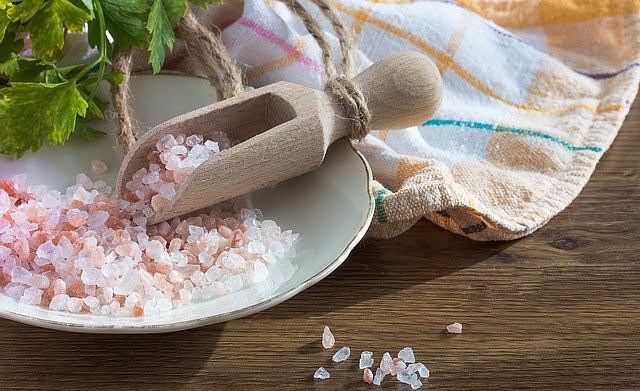When you have more information about how your body responds to any problem, then managing it becomes easier. No exception with migraine headaches, one of the best ways of preventing migraine attack is identifying what triggers an attack. From there, it simple to avoid them as possible. If you are suffering from migraine and also a fan of Himalayan salt, then this article is for you. Here we discuss Can Himalayan Salt Cause Migraines?, specifically, can the salt intake trigger a migraine attack?
Severe and frequent headache can make the situation worse. So, as we all know, it’s better to be safe than sorry, especially in the condition of migraine.
Once you are sure that your migraine does not result of any medical issue as discussed in this article then you can try out the effect of your food and lifestyle (e.g. Himalayan salt intake) to prevent yourself from a headache (migraine attack).
Firstly, let’s find out what we mean by Himalayan salt.
What is Himalayan Salt?
Himalayan Salt, which is also known as pink salt and Chinen Salt, is made from crystals of rock that are mined from areas located near the Himalayas, Pakistan.
Himalayan salt is mostly found as small crystal form. They have rosy color due to trace minerals in the salt such as calcium, potassium, and magnesium. Most people claim that Himalayan or pink salt has many more minerals in it; that is why they have incredible health benefits.
In Pakistan, Himalayan salt is extracted mostly from Khewra Salt Mine, located near the Himalayas. Khewra Salt mine is known as one of the largest and oldest salt mines in the world.
Generally, pink salt is gathered by hand. Then it is refined to use as an alternative to regular table salt.
Tip: Have you heard about Himalayan salt brick walls?
How Himalayan Salt Different From Table Salt?
From this appearance, one can easily distinguish Himalayan and table as the former is in pink and the latter is in white color.
In addition, pink salt is loaded with more minerals as compared to table salt. So Himalayan salt is much healthier than regular salt.
Furthermore, little research has been done on the benefits of Himalayan salt, but some researchers claim that Himalayan salt health benefits are not more than rumors.
White salt is a crystalline mineral which has 60% of sodium and 40% of chloride.
Consuming too much salt may lead to high blood pressure and other heart diseases, but researchers say that eating not enough salt can also cause harmful effects on the human body.
Table salt is extracted from natural deposits and heated at 1,200° F in order to remove all the impurities. As regular salt is a product of crushed processing, so the majority of its trace minerals and contaminants are removed.
The common salt which is used in food also contains iodine around 3% with 97% of Sodium Chloride. So food-grade table salt are not 100% natural. Suppose if you feel reluctant in using iodized salt that you can have such foods which are rich in iodine like eggs, fish and dairy products.
However, one thing must be remembered that often regular salt includes preservatives such as anticaking agents, which keeps away from clumping the salt. Therefore, it not as natural as it looks.
On the other hand, Himalayan pink salt is sourced by hand in Pakistan from one of the largest mines in the world. It has a different color and flavor from table salt.
Himalayan salt has a pink color which is rich in calcium, potassium, iron, magnesium. Its have much more minerals than table salt. However, as an overall the pink salt is lower in sodium whereas, table salt is rich in sodium chloride.
As a result, the Himalayan salt is considered as one of the pure varieties of salt. Although it also may contain some amount of iodine which is less than what found in iodized table salt.
Tip: Did you know how the Dead Sea Salts are different from the regular sea salt?
Now, let’s turn on the migraine and migraine attacks.
What is Migraine?
According to researchers, migraines are headaches which continuously occur with short or long-time intervals. Pulsing or throbbing are caused by migraine pain. Migraine pain often occurs on one part of the head.
A patient can also experience other symptoms, such as weakness or nausea. The patient may also become sensitive to sound and light.
What Causes Migraine?
Migraine causes may vary from person to person.
According to researchers, there are a number of different causes of migraine, and one of the most significant cause for it is genetics.
Following are the factors which can trigger a migraine attack.
- Stress level
- Medicines
- Over/less sleep
- Change in temperature
- Inappropriate diet
- Loud noise
- Smoking
- Overdose of medication
- Strong smell
- Anxiety
- Strong flashlights
- Caffeine intake or withdrawal
- Hormonal changes in women
However, the study says that certain ingredients or food may also cause migraines when they are combined with other causes. Following are the ingredients and food which can cause migraine.
- Yeast
- Aged cheeses
- Alcohol
- Nuts and fruits
- Processed meat
- Pickled food
- Chocolate
- Monosodium glutamate (MSG)
What Triggers Migraine Attacks?
Everyday routine things can trigger a migraine headache like exercise, drinks, stress, lack of sleep, hunger, foods, smells, hormonal changes in women. These are the names of a few causes which can trigger a migraine attack.
Tip: Himalayan salt inhalers can help you sleep well.
To find out what brings migraine within you, you can make a checklist. Then review your list after every few weeks to spot the pattern of your migraines correctly.
Below are the key types of triggers.
1. Environmental Triggers
The surrounding in which we are living may become a reason for migraine too.
They include…
- A stuffy atmosphere
- Loud noises
- Bright lights
- Strong smells
- Changes in the climate like humidity or low temperature
- Flickering screens of computer, laptop or television
2. Physical Triggers
- Exertion
- Tiredness
- Sleep posture
- Neck or shoulder tension
- Lack of sleep
- Over sleeping
- Jet lag
- Exercise
3. Hormonal Triggers
Most women experience migraine when their period date is close. It is because of the level of hormones changes such as estrogen at that time. Commonly, this kind of migraines occurs 2 to 3 days before the start of the menstrual cycle.
Those who only experience migraines at the time closer to menses are diagnosed to have a pure menstrual migraine.
On the other hand, those women who experience a migraine at other times too are known to have a menstruation-related migraine.
Many women experienced that their migraines get better after the menopause. But still, menopause could trigger migraines or make them worse.
4. Dietary Triggers
Irregular meals can be the biggest reason for migraine. Skipping meals or delays can make the situation worse.
The dehydrated body is also more exposed to migraines.
Usage of alcohol and caffeine products such as coffee or tea can result in severe migraine headaches.
However, food which is stored at room temperature or item that are stored at shelf instead of being stored in a refrigerator can increase the level of tyramine in them. The food item which contains tyramine in them could be yeast, pickled herrings, certain kind of cheese, cured meat, smoked fish and others. For some, they all can act as migraine triggers.
5. Medicines
Some kind of medicines can cause migraine, like sleep tablets and relaxants.
Also, certain kind of therapies like Hormone Replacement Therapy known as HRT, which is used to relieve symptoms related to menopause, can also trigger migraines.
Other than that combined contraceptive pill can also result in a migraine headache.
6. Emotional Triggers
All the below emotions can act as a trigger.
- Excitement
- Tension
- Stress
- Shock
- Panic
- Depression
- Anxiety
Can Himalayan Salt Cause Migraines?
Yes, it can but that is unlikely. On the contrary, lack of salt can cause migraines compared to the other way around.
Any kind of deficiency in your body, including sodium chloride (NaCl) could affect your brain cells, which can begin the migraine process. That is based on the theory of Dr Svetlana Blitshteyn who studied about and treated nervous system disorders at the University at Buffalo School of Medicine and Biomedical Sciences (New York).
She has specialized in disorders of the autonomic nervous system, which involved in controlling all our automatic functions of the body such as urination, breathing, and heart rate. Svetlana has treated many patients who were suffering in migraines. Then she noticed that in patients who start consuming excess amounts of salt as a cure for different conditions, the migraine symptoms often got better. However, this condition is just anecdotal and not proven by any wider publications.
When Himalayan Salt Cause Migraines?
Furthermore, salt has its own risks. It has been linked to common heart diseases and stroke. So it is not confirmed that it triggers migraine or not. But studies have shown that lack of sodium chloride can be a reason of migraine.
Can Himalayan Salt Help Migraines?
Yes, Himalayan salt can help you during a migraine.
If you are suffering from severe migraines and looking for non-pharmaceutical options for treatments, surely then you may have come across with the remedy of drinking water with lemon juice and Himalayan salt. This can help in reducing migraines. The big reason that this remedy might be effective is that it boils down to a very prevalent migraine trigger: dehydration.
If dehydration is the factor behind your migraine, then the simple trick of preparing mixing Himalayan salt and fresh lemon into freshwater will help you to feel better.
Although most of the patients with migraine know what are the causes of their migraines, the majority of their symptoms are related to diet, both what we opt to intake and what we ignore.
Lack of water can be a significant cause of migraines which can lead to loss of appetite.
If a patient is suffering from nausea in migraine, then most likely it means that his/her body is in electrolytes and low on fluids, including sodium.
Let’s look at a research scenario to understand it better.
Case Study
A research study was done at Huntington Medical Research Institutes in Pasadena, California by Harrington and his colleagues. They conducted the National Health and Nutritional Examination Survey, of diet and health of 10,000 people. They asked respondents to narrow down everything they have consumed in the last 24 hours. Also in that time interval whether they had a headache or migraine.
This study was conducted between 1999 and 2004, where 8819 people have tested with the highest level of sodium chloride in their diets. Therefore, they reported the fewest severe migraines and headaches compared to the average.
Results
Harrington and his colleagues suggested that these patients are counter intuitive. The results showed that sodium ion, which are considered as ‘active neurons’ when they reach a high level, they make neurons more excitable. So, they prevent migraine activity. Their results were the opposite, as they were expecting the sodium relation to go in any other direction.
How To Treat Migraine Headaches with Himalayan Salt?
Hydration occurs due to the imbalance of electrolytes and fluids. One can prevent and this imbalance by replenishing body supply. In this situation, one must increase the intake of liquids and electrolytes.
Also, refrain from consuming drinks or food item that drain fluids from your body, such as juiced drinks and liquor is important.
To treat your dehydration, and to control migraine effectively, it is essential to supplicate your lost electrolytes regularly. One of the easiest ways is to use Himalayan salt in your diet.
As noted, Himalayan salt is a good source of minerals such as calcium, potassium, and magnesium. This salt can helps in restoring the imbalance of electrolytes in your body.
To this end, numerous individuals drink a refreshment called Himalayan Salt Sole to help avoid or treat lack of hydration ‘cerebral pains’. Calorie Bee offers a simple formula that utilizations water, pink Himalayan salt and lemon juice to treat migraines and improve your general well being. Notwithstanding calming ‘cerebral pains’, this beverage may likewise build your vitality, lessen irritation in the body, support your resistant framework, and that’s just the beginning.
Salt and Lemon Juice Recipe for Migraine
To check your body is dehydrated or not, you must monitor the pattern of your urine.
A dehydrated body produces dark yellow color urine, whereas, a well-hydrated body produces clear and colorless urine.
You can experience dry skin, poor coordination, fatigue, decreased urine output, impairment of judgment, blood pressure changes, dry mucous membranes in the nose and mouth in mild dehydration – all as a result of dehydration.
Tip: Do you think Epson Salt Baths can lower blood pressure?
If you are suffering from migraine then instead of trying out any medicine, try this recipe to keep you well hydrated.
The Lemon and Himalayan Salt Drink Recipe
- Fill a glass jar ¼ of the way with ground or chunks of Himalayan Salt. Fill it with water and shake well. Use a plastic, non-metal lid for the jar to cover.
- Let sit overnight. If all salt dissolved, add more.
- Take a teaspoon upon waking up and mix into a glass of water, you can also add a few drops of fresh lemon.
Tip: You could try it with Smoked Salt too! The link will take you to our Smoked Salt Guide.
Conclusion
Migraines are a recurring type of headaches. Generally, they are transferred through ancestors from a generation to another. One of the most common benefits of Himalayan Salt is that it can decrease migraines. Himalayan Salt can also help in treating cerebral pains – even headaches.
During a migraine condition, one may suffer from vomiting, nausea, sensitivity to sound, smell or light, visual disturbances, numbness in the face.
Today migraines are not a rare problem. An estimated 1 billion people around the world are suffering from the neurological condition. In other words, it’s hard to find a person who has never experienced a migraine in their lifetime.
Drinking Himalayan salt added drink along with few drops of lemon can work wonders for migraine patients. It is advised to drink it after waking up, regularly.
As always, my recommendation is to check with your doctor first before making considerable changes to your lifestyle.












